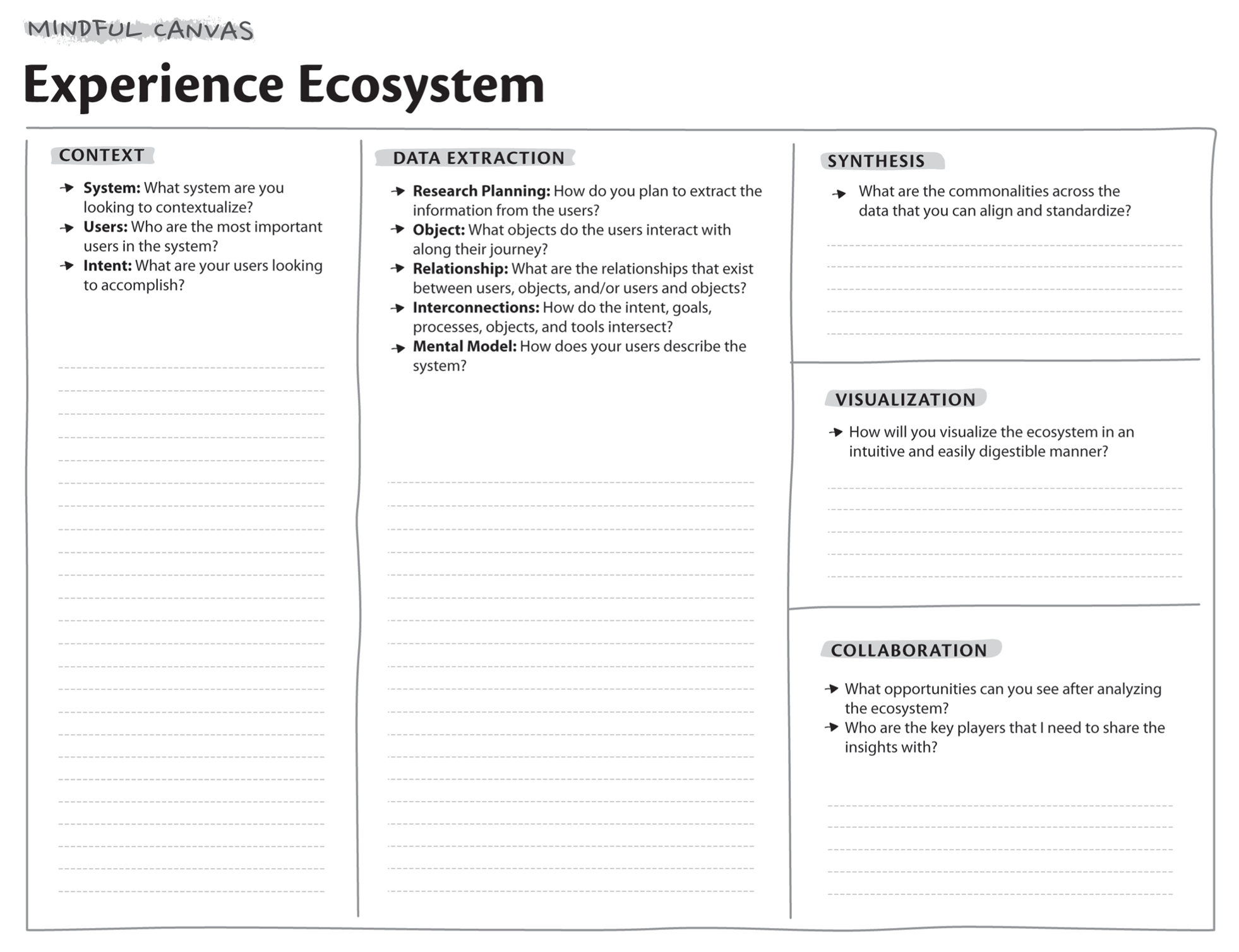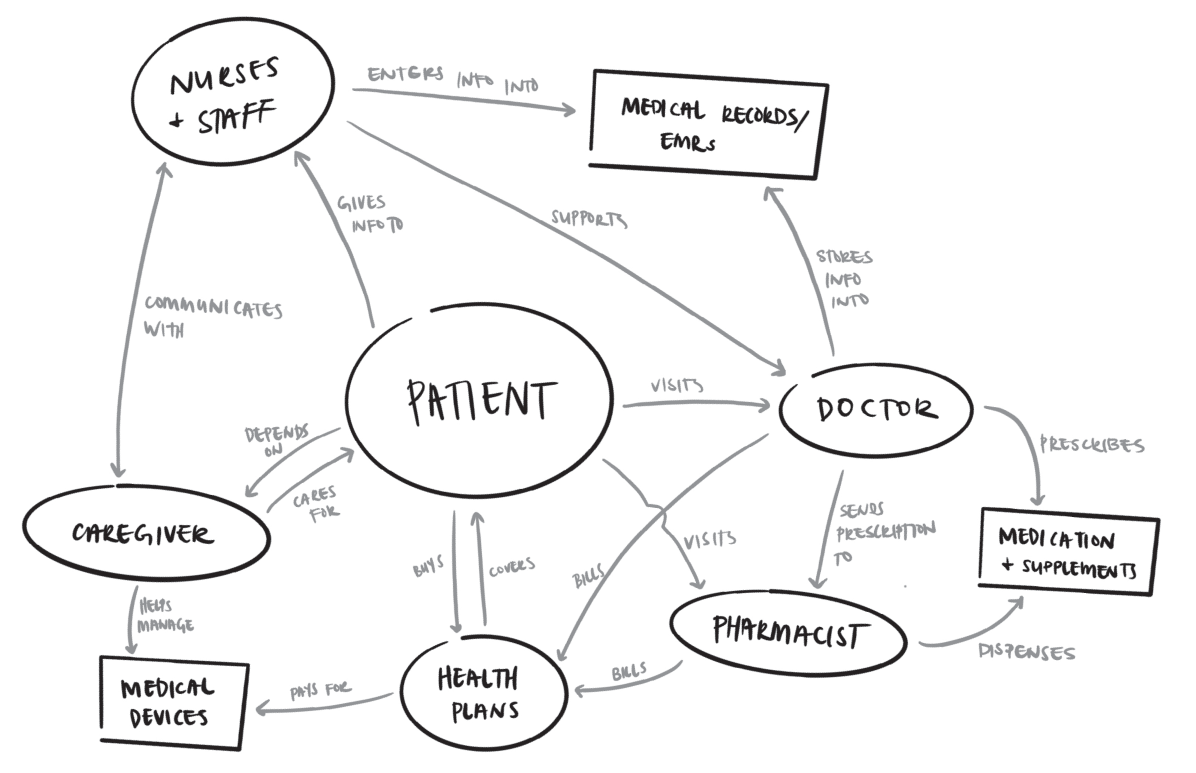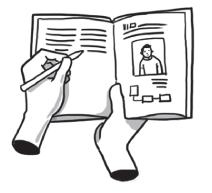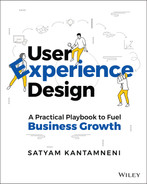CHAPTER 18
EXPERIENCE ECOSYSTEM PLAY: How do I build a seamless experience for the user across the entire ecosystem?
Many companies make the mistake of focusing too much on one user or one product. They overlook the ecosystem—the complex network of interconnected systems that their product and company inhabits. The experience ecosystem play enables you to see the forest before focusing on the individual trees. Building an experience ecosystem is a powerful tool for unleashing tremendous business value. It allows you to identify M&A acquisition targets, reveals the new complementary services your users want, and streamlines the workflow and processes that will bring delight to your customers.

Who Are the Key players in the Experience Ecosystem Play?
| ROLE | WHO’S INVOLVED | RESPONSIBILITIES |
|---|---|---|

DRIVER | Experience strategist |
|
 CONTRIBUTOR |
|
|

THE HOW
To build an effective experience ecosystem, you need to be mindful of the following:
1. The CONTEXT of the User and the System
- System: What system are you looking to contextualize? A system could be a product, platform, a business or organization, or a business unit.
- Users: Who are the most important users in the system? Each system will likely have more than one user, and they will likely come from one of the following categories: revenue‐generating customers, company employees, external vendors, or partners. List and then prioritize all the users who play a role in your ecosystem.
- Intent: Each of these users has a goal they want to accomplish in the system you have created. What is this goal? Identify your users’ intent; this will serve as an anchor in creating the experience ecosystem.
2. EXTRACTING DATA from User Research
Guided by your understanding of the system, users, and their intents, plan and conduct user research to extract the information necessary to visualize the ecosystem.
Research planning: There are multiple ways to extract information out of the ecosystem. You can either conduct user research (Chapter 30: “User Research Program Play”) and/or speak with internal employees who interact with users on a regular basis.
Through these activities, try to understand the user and their journey navigating across the system to achieve an intended goal. Capture the following details:
- Objects: Objects are artifacts that users encounter across the system while accomplishing certain tasks. Track the list of objects and organize them by user.
- Devices and Channels: How are your users receiving those objects? What devices (e.g. phone, desktop), channels (e.g. social media, phone, mail), and modalities (e.g. web, mobile) serve as the intermediary to transfer the objects? Make sure you group the devices and channels in conjunction with the corresponding object for easier mapping later on.
- Relationship: Identify the relationships that exist between users, objects, and users and objects. Picture them as connected lines on a workflow or process map. Map the relationship between the elements, and denote flow by using arrowheads.
- Users’ Mental Model: What users believe about the system at hand strongly influences how they use it. Mismatched mental models are common, especially with designs that are new or unfamiliar. That is why it’s important to gather firsthand insights about the user’s mental model. How does the user talk about the system in their own words? Don’t assume—ask them to describe it. Anywhere there’s a significant discrepancy, make a note; this may be an area where you should make the system conform to the user’s mental models.
3. SYNTHESIZING Data to Find Patterns and Correlations
Synthesize and rationalize all of the data that you’ve extracted (e.g. objects, relationships, terminologies) across users. Individual users each have their own mental models, influenced by factors such as location, cultural background, technical knowledge, and functional silos. This may lead to different people using different terminologies to refer to the same objects or processes within the system. Thus, it’s important to find commonalities, align, and standardize, employing further user research when necessary to bridge the gap.
4. VISUALIZING the Experience Ecosystem
Visualizing the full experience ecosystem, especially from a user’s perspective, is a powerful tool: It presents an immense amount of data in an intuitive and easily digestible manner. Visualize the eco‐system by putting your user in the center. The other people or roles your user interacts with are denoted in circles, and the objects they receive or exchange are denoted in squares. The relationships and sequence of actions are illustrated using labeled arrows.
5. COLLABORATING Proactively across the Organization Based on Insights from the Ecosystem
Socialize the Experience Ecosystem

Share the ecosystem with the stakeholders who play a role in shaping your users’ experience. Show them how their individual touchpoints with the customer contribute to the greater ecosystem. Establish a common understanding of the user and seek alignment across stakeholders.
Leverage the experience ecosystem’s value for your team, business, or product experience as you:
- Allow your team to focus (team);
- Rationalize the design system to drive consistency across product and platforms (design);
- Design and then build the best workflows based on the ecosystem (design);
- Identify user experience gaps (design);
- Identify and remove existing inefficiencies within cross‐functional processes and departments (business);
- Break down organizational silos that lead to a poor user experience (business);
- Uncover gaps in business model, technology, or capability (business);
- Pursue new markets that are complementary to your product and related experiences (business);
- Forge new partnerships or identify mergers and acquisitions (M&A) opportunities (business).
IN ORDER TO MAXIMIZE THE VALUE OF THIS PLAY
- Just do it. You can build a first draft in a matter of hours and perfect it with dedication and commitment in less than one week. Immediately, the tool will allow you to see the broader context and get alignment across the organization.
- Continually socialize the experience ecosystem to all the teams across the product.
- Evolve and update the experience ecosystem on an ongoing basis. It’s a living artifact that needs constant iterating, especially after changes in the organization or external forces have effected a material change to the user’s experience.
 RELATED PLAYS
RELATED PLAYS
- Chapter 14: “User Empathy Play”
- Chapter 28: “Experience Metrics Play”
- Chapter 29: “Insights Curation Play”
